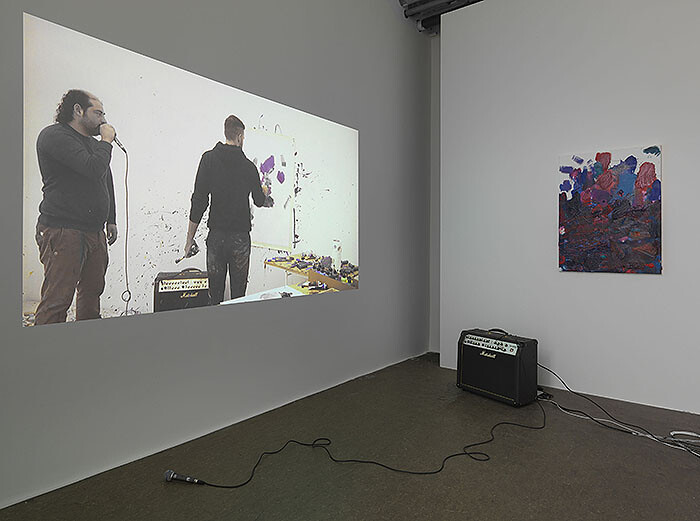Two artists stand in a studio. One holds a brush, the other a microphone. Romanian painter Adrian Ghenie(1) feverishly walks back and forth between the canvas and his palette and seems completely undisturbed by the pervasive vocal interpretations Dutch-Iranian artist Navid Nuur makes of his rude brushstrokes. This work, The Possibility of Purple (2013), documents the making of five paintings in five separate videos, all approximately thirty minutes in length. Everything is shot from the same angle. Ghenie taps, draws, throws, and smears thick layers of red and blue paint on the canvas while Nuur growls, howls, and occasionally creates cartoon-esque “blub!” noises in response to each of Ghenie’s gestures. Yes, it’s very entertaining to watch, but above all, the extensive film turns out to be the key piece in this elaborate, two-person exhibition “On the Road to … Tarascon” at Galeria Plan B, which encompasses painting, video, performance, and sound. Transformed into a small replica of the video scene, the gallery space incorporates one of the paintings from the video series on the back wall; the microphone and Marshall amplifier that Nuur used is positioned to its left, and Ghenie’s white paint-mixing stand to the right.
For an exhibition that is geared towards an unexpected coming together of artists and their collaborative research, it’s fascinating to actually see both artists at work in their collective search for a language that investigates modern painting and its position within the disciplines of contemporary art and art history. Moreover, in the collision of their practices, the work embodies the unforeseen intimacy and vulnerability between Ghenie and Nuur—not to mention how they each benefit from their exploration of one another’s practice. This energy is palpable throughout the entire exhibition.
Ghenie is known as a figurative painter and in the aforementioned videos exclusively employs Nuur’s beloved red and blue tints in order to create five abstract paintings. Witnessing Ghenie as he works with such a limited range of color and no “figure” to paint is actually exciting, and he seems to go about it effortlessly. As a viewer you realize that this work explores color and texture as much as any other painting, figurative or not, and perhaps even more so. With great efficacy, Ghenie demonstrates that the research of painting lies in its process of production and not in its final results. Simultaneously, Nuur, ever the conceptual artist, emphasizes his creative process by illustrating the relation between the physical act of painting and the body that applies the paint.
The exhibition’s title “On the Road to … Tarascon” is based on Francis Bacon’s 1956–57 series of paintings inspired by a self-portrait by Vincent van Gogh, The Painter on the Road to Tarascon (1888, destroyed). Three paintings carry the show’s title, two of which Ghenie and Nuur painted together. On the Road to Tarascon 2 (2013) hangs in the gallery’s entrance and features an even gloomier interpretation of Bacon’s silhouette of the painter, flanked by dark trees and standing under an eerily dark blue sky. Nuur has painted a veil over the already dark picture in thick, black, and disconnected Van Gogh-like strokes. Surprisingly though, the black on black approach does not diminish the details in the final work, but instead highlights and enhances them. On the Road to Tarascon (2013), a diptych hung in the main space on the back wall, is a somewhat brighter rendition of the original scene. Ghenie’s luscious use of color and texture serves as a blueprint for Nuur’s abstract interpretation of it, which is shown on the left side panel. Again, he paints in the spirit of Van Gogh’s infamous tightly arranged, rhythmic brushstrokes even though he follows the pattern drawn by his colleague. Both paintings represent an intimate collaborative effort and are exercises in the abstract nature of the figurative—as well as the traditional, symbolic, and figural—act of painting, whereby two artists partake of the tools and surfaces of the other.
Another unexpectedly intimate moment is captured in the array of objects displayed on the front desk that Nuur created from the rejected material he found on the floor of Ghenie’s studio. Using leftovers from his paintings and turning them into colorful, amorphous peep-boxes, Nuur’s role as the conceptual artist in this configuration really comes to the fore: he proves that in his practice he has the time, and above all, the flexibility for inventive interpretation.
In addressing art historical figures like Van Gogh and Bacon, both Ghenie and Nuur tap into a much longer tradition of collectivism with a decisively political pedigree. Rejecting a canonical view (one based on the authority of monographic exhibition catalogs), Ghenie and Nuur emphasize their personal take on the political, social, and cultural scheme of things, not necessarily in order to make an appeal to the viewer, but rather to educate themselves. Even more so, “On the Road to … Tarascon” upholds the notion that fact and fiction, memory and projection, not only commingle with one another, but are also inseparable from the making of (art) history. This collection of research-based works is intrinsically linked to social, cultural, linguistic, and economic factors. In light of the history and ideas surrounding Van Gogh, a sense of collective belonging, real or imagined, is part and parcel of the viewer’s subject formation. And yet, the encounter and intertwining of these two artist’s discourses(2) and practices generates an entirely new means of prospecting in the history of art.
1) Adrian Ghenie is one of the founding members of Galeria Plan B where he, together with Mihai Pop, opened a space meant for research and exhibitions with a strong focus on modern and contemporary Romanian art. The original location of the gallery opened in Cluj, Romania in 2005. 2) Their meeting is partially documented in an extensive conversation between the two artists on the gallery’s website (http://www.plan-b.ro/reader/).









